
Ever wondered which herb truly reigns supreme? Forget about rosemary or mint for a second—because when it comes to herbs proven by thousands of years of use and backed by modern science, holy basil, better known as tulsi, stands way above the crowd. Imagine an herb considered sacred not just for its aroma or taste, but for literally transforming health outcomes for millions—from ancient temples in India to contemporary research labs. Tulsi isn’t just some trendy health buzzword—it’s woven into spiritual rituals, used in kitchens, and relied on by healers. Curious how one humble plant earned a nickname like “The Incomparable One?” Stick around. This isn’t just about a leaf; it’s a legend.
The Unmatched History and Cultural Influence of Holy Basil (Tulsi)
Tulsi, or holy basil, isn’t your average kitchen spice. In India, you’ll find a tulsi plant in the courtyard of almost every traditional home, treated with more reverence than even the family dog. Why? Because in Hinduism, tulsi is considered a goddess. Daily offerings and prayers revolve around this humble shrub, which some believe protects the home from negative energy and illness. This spiritual side is just the beginning. Ancient Sanskrit texts—dating back over 3,000 years—describe tulsi as an adaptogen, helping people thrive even when life gets stressful. You probably won’t find another herb with an annual festival in its honor, either, like the Tulsi Vivah celebrated every November.
Jump east or west a few continents and you’ll notice holy basil making its mark in traditional Chinese medicine and even medieval European practices. Some stories say travelers carried it as a protective charm against infections—and guess what? They might have been onto something. This tiny plant bridged spiritual, medicinal, and even everyday life. Kings prized it as a remedy and as a good luck charm, while healers reached for it to treat everything from stomach troubles to snake bites. That cross-cultural appeal grew tulsi’s reputation as the king of herbs.
Fast forward to today, and tulsi is still holding court. You’ll spot it on altars and in aisles of fancy organic stores in New York or London, in teas claiming to calm nerves, and supplements promising immune boosts. Not many herbs can brag about a resume this long or a fanbase this loyal. It’s a rare blend of spiritual fame and everyday usefulness that’s kept tulsi top-of-mind for over 3,000 years.
Just to give you a snapshot of tulsi’s reach, check out this quick table:
| Region | Use of Tulsi | Era |
|---|---|---|
| Ancient India | Spiritual rituals, medicine | 1500 BCE–present |
| China | Traditional healing, adaptogen | 200 CE–present |
| Europe | Home remedy, magical protection | Middle Ages–present |
| Worldwide | Modern supplements, tea | 2000s–present |
What Makes Tulsi a Powerhouse Herb Scientifically?
Let’s talk hard facts, not just legends. Tulsi’s big claim to the herbal throne comes from its unique combination of phytochemicals. Researchers have found more than 50 compounds in tulsi leaves and stems, including eugenol (which is also what gives cloves their punch), ursolic acid, and apigenin. These have antioxidant, anti-inflammatory, and even antimicrobial powers. In a study published in 2017 in the "Journal of Ayurveda and Integrative Medicine," scientists found that tulsi can boost the body’s ability to fight off everything from bacteria to viruses. That might explain why your grandma’s go-to cold remedy was a steaming, spicy tulsi tea.
But that’s just scratching the surface. Modern clinical trials show that tulsi can help lower blood sugar in people with type 2 diabetes. In one small randomized trial, participants who took tulsi extract for eight weeks saw their fasting blood sugar drop by nearly 10%. Another study in 2022 out of AIIMS, Delhi, found that tulsi leaves may support the immune system by increasing the production of natural killer cells—those are the body’s front-line soldiers against infections.
Struggling with stress? Tulsi’s adaptogenic properties live up to the hype. In a double-blind, placebo-controlled study, people who took holy basil extracts reported less anxiety and improved mood in just 30 days. Here’s the simple trick: tulsi helps balance cortisol, your body’s main stress hormone, so you feel calmer and less frazzled by daily life. No wonder it’s called an adaptogen; this herb literally helps your body adapt.
Here’s a rundown of what tulsi can offer, backed by studies:
- Boosts immunity and fights infections
- Lowers blood sugar and cholesterol
- Supports healthy digestion and metabolism
- Reduces stress and anxiety levels
- Protects against cellular damage with antioxidants
- May help with asthma and respiratory problems
- Even acts gently as an insect repellent (yep, no joke)
The best part? Unlike some fanciful health supplements, tulsi’s side effects are rare and usually mild—sometimes just a bit of stomach upset if you overdo it. It’s no miracle cure, but it sure has a whole toolbox of benefits for such a small plant.

Real-World Uses: How People Include Tulsi in Daily Life
If you think tulsi is just for teas or supplements, you’re missing out. Ask an auntie in Mumbai or a yoga teacher in Los Angeles: tulsi is as versatile in the kitchen and medicine cabinet as it is in a garden. People use its leaves to flavor food—think herby chutneys, spiced drinks, and even as a peppery salad addition. In South India, tulsi leaves are sometimes chewed raw to soothe sore throats or mixed into warm water for a quick detox shot after a heavy meal.
It’s also a beloved tea herb. Those rough days when work emails pile up? A hot mug steeped with tulsi, ginger, and a spoonful of honey is an instant spirit-lifter. Some families cherish their own unique “tulsi tea” recipes, passed down like secrets from generation to generation. You’ll find ready-made tulsi tea blends crowding health food store shelves, promising everything from better sleep to a clearer mind.
Tulsi isn’t just for sipping, though. Homemade face masks with tulsi powder are a go-to for clearer skin. Got a small cut or bug bite? Freshly crushed tulsi leaves soothe it faster than many creams or ointments. There’s a reason why Ayurveda practitioners call tulsi “Mother Medicine of Nature.”
- Tulsi Infusion: Add a handful of washed tulsi leaves to a pot of boiling water, let it steep, and enjoy as a base for herbal remedies or drinks.
- Fresh Tulsi Paste: Blend leaves into a paste for topical use—just don’t forget to patch test if you have sensitive skin!
- Natural Air Purifier: Keeping a tulsi pot by the window isn’t just tradition; research from the Indian Institute of Technology shows tulsi naturally helps purify indoor air by combating certain bacteria and toxins.
Parents in India often swear by a tulsi-honey syrup for nagging coughs. Even pets get a boost—some folks add a tulsi leaf or two to their dog’s water for fresh breath and a little immune support.
Here’s a table to show the clever ways people use tulsi daily:
| Use | How It Helps |
|---|---|
| Tea | Calms nerves, supports immunity |
| Face Mask | Clears acne, soothes skin |
| Cooking | Adds flavor, aids digestion |
| Air Purifier | Reduces microbes in air |
| Syrups | Soothes coughs, eases sore throat |
The beauty of tulsi is its pure practicality. You’re just as likely to see it next to a medicine cabinet as on a dinner plate.
Surprising Facts You Probably Didn’t Know About Tulsi
If you thought tulsi’s just a grandma’s remedy, brace yourself. Scientists have recently discovered that its oil can fight mosquito larvae better than some synthetic chemicals. In places prone to malaria, this makes tulsi an eco-friendly option to help keep those bugs at bay. And back in 2020, a study out of Hyderabad revealed that tulsi’s essential oils have strong action against the bacteria that cause dental plaque, hinting at a future for tulsi-flavored toothpaste. Imagine brushing with tulsi in the morning instead of mint!
Unlike many herbs, tulsi comes in several varieties. The most famous are Rama (bright green), Krishna (dark purple-green), and Vana (wild, often with smaller leaves). Each has its unique flavor and benefits, though all carry the core healing punch. In Ayurveda, Krishna tulsi is prized for respiratory support, while Rama is favored for calming the nerves. No wonder families keep at least two types growing on a sunny windowsill!
And get this: in several studies, tulsi has outperformed store-bought mouthwash in fighting harmful oral bacteria, all without the chemical aftertaste. Plus, tulsi’s been found to help maintain healthy cholesterol levels, ease asthma symptoms, and even speed up wound healing in some animal models. Its leaves contain vitamin C, vitamin A, calcium, zinc, and iron—basically, a multi-mineral, multi-vitamin punch in one bite. It’s like a protein bar, minus the wrapper and processed sugar.
Throughout the COVID-19 pandemic, tulsi teas and tinctures saw a worldwide surge in popularity, especially when people wanted natural ways to boost immunity and breathe easier. Some Indian state governments even distributed tulsi plantlets to families, hoping a little greenery would help keep communities healthier.
And if you’re into gardening, here’s a pro tip: tulsi is super hardy. Drop a seed in some good soil and keep it in a sunny spot; you’ll have a low-maintenance plant that keeps giving all year. Plus, tulsi repels some garden pests, making it a companion plant to tomatoes and peppers. Double win.

Tips for Growing, Harvesting, and Using Tulsi at Home
Thinking of adding some “royal” power to your home? Tulsi is ridiculously easy to grow indoors or out. Start from seeds if you’re patient, or grab a small plant from a nursery—just make sure it gets 4-6 hours of sun a day. Water it regularly, but let the soil dry out a bit in between. Too much water—the roots rot. Too little—it sulks. Easy balance: water when the top inch of soil feels dry. Pinch back the tops to keep it bushy, and don’t be shy about picking leaves, because that’s how tulsi thrives.
When harvesting, always choose the mature leaves. Pluck them in the early morning for the biggest flavor and medicinal punch. Air-dry those leaves out of direct sunlight, crumble them, and store in a jar for tea, tinctures, or even homemade skincare.
Want to make a foolproof tulsi tea? Here’s how:
- Grab 8-10 fresh tulsi leaves (if using dry leaves, a tablespoon works).
- Bring a cup of water to a boil.
- Add the leaves, turn off the heat, and let it steep 5-10 minutes, covered.
- Strain, add a bit of honey or lemon if you like, and sip hot.
Or toss a couple of fresh tulsi leaves in your salad, atop a slice of pizza, or even in a smoothie. For a face cleanser, mix finely crushed tulsi with a splash of rosewater—gentle, no-fuss, and very refreshing.
Got kids? Skip the chemical-laden stuff and let them chew a tulsi leaf after a meal for fun and fresh breath. Pets can have a few tiny shredded leaves in their bowl every now and then, just don’t go overboard. And those with allergies or pregnant women should always check with a healthcare provider first—herbs are powerful, and it’s smart to be safe.
One more tip: share your tulsi! Give a cutting to a friend, neighbor, or new roommate. You’ll spread good vibes, maybe a little extra immunity during cold season, and definitely start some interesting conversations. Not bad for an ordinary-looking plant, right?

Write a comment